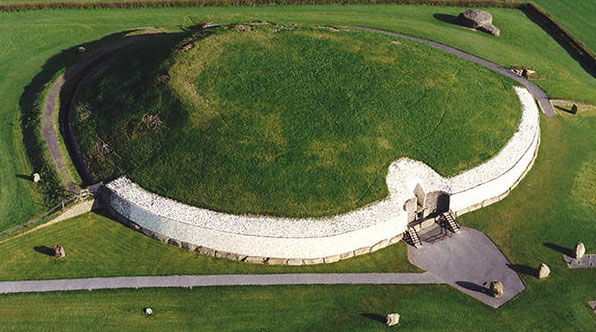What is Newgrange?
Newgrange is a Megalithic Passage Tomb from the pre-historic era known as the Neolithic. It dates from approximately C.3200BC making is approximately 5000 years old, predating Stonehenge and the Pyramids at Giza. The Tomb is a large mound with one entrance that leads to a long passage and internal chamber with 3 adjacent chambers known as a cruciform which contains basin stones which contained cremation burials.
Contact Details for Newgrange
brunaboinne@opw.ie
Brú na Bóinne Visitor Centre
Donore
Co. Meath
Republic Of Ireland.
Phone +353 41 988 0300
Amenities at Newgrange
The Boyne Valley Visitor Centre is light and airy with a lovely restaurant and tea rooms, with lovely staff that were extremely helpful and very friendly.
There is a well stocked gift shop with a wide range of items for all ages, they also have a wide range of books available.
There are Toilet and disabled toilet facilities
The Visitor Centre has an informative exhibition for archaeological items and reconstructions for many archetural structure that would have been used during the Neolithic period and beyond.
Where is it located?
The Boyne Valley. Co Meath.
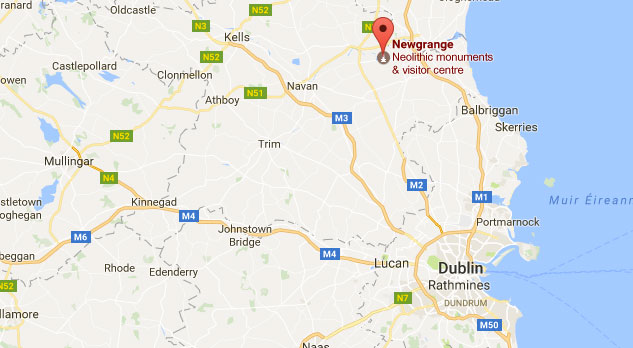
How much does it cost?
Visitor Centre
Child/Student: Euro 2.00
Adult: Euro 3.00
Senior/Group: Euro 2.00
Family: Euro 8.00
Visitors Centre and Newgrange Megalithic Tomb
Child/Student: Euro 3.00
Adult: Euro 6.00
Senior/Group: Euro 5.00
Family: Euro 15.00
Visitors Centre and Knowth Megalithic Tomb
Child/Student: Euro 3.00
Adult: Euro 5.00
Senior/Group: Euro 3.00
Family: Euro 13.00
Visitors Centre, Newgrange and Knowth Megalithic Tombs
Child/Student: Euro 6.00
Adult: Euro 11.00
Senior/Group: Euro 8.00
Family: Euro 28.00
Tours of Newgrange
Guided tours of the Newgrange and Knowth monuments start at the Brú na Bóinne Visitor Centre, there is no public access to the monuments unguided. Access to the monuments is via a short walk to the bus pick up point. Buses will drop and collect visitors from the monuments.
What are the opening times
Opening Hours
Closed December 24th-reopens to public Dec 28th February – April: Daily 09.30 – 17.30.
May: Daily 09.00 – 18.30.
June – Mid September: Daily 09.00 – 19.00.
Mid – End September: Daily 09.00 – 18.30.
October: Daily 09.30 – 17.30.
November – January: Daily 09.00 – 17.00
Sinead’s thoughts on Newgrange…
If you have a bucket list for things to see in Ireland put Newgrange on the top of that list! For me this spectacular monument stands as a constant and enduring reminder of Ireland’s Celtic past, and where our glorious mythology and legendary Heroes come to life.
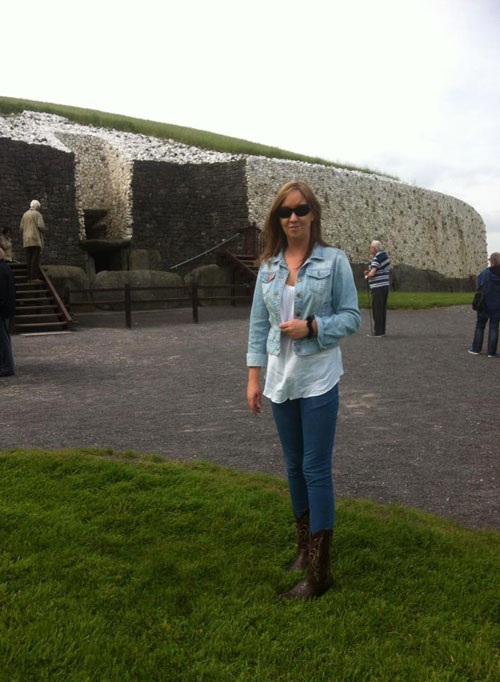
As you walk from the visitors centre along a tree lined walkway you are reminded that this mystical landscape of the Boyne Valley hasn’t changed much for thousands of years. The leaves seem to whisper with the memories of our prehistoric ancestors. For me with an obsessive addiction to history and archaeology visiting this sacred site was like a pilgrimage to meet the ghosts of ancestors that deeply influences many parts of our modern culture and the pride we feel in our history.
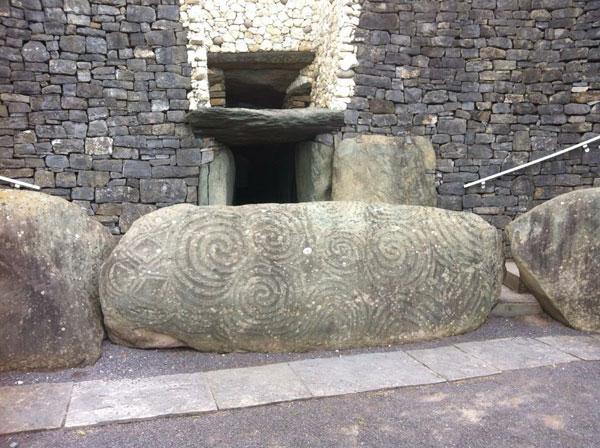
On approaching the monument in a bus, you will be in awe of its size and impact on the landscape. It’s difficult not to think about the rituals that would have taken place here.
The tour guides were wonderful and engaging. Entering the monument was a surreal experience and you will be advised is you are cluster phobic wait until last to enter the monument as you will be the first out. Take in the ancient art on the large stones outside the tomb entrance and you are just drawn to the fact these were carved by a person thousands of years ago.

The entrance passageway is narrow and the internal chamber is small but is a privilege to stand in. You will be able to see the internal chambers very well and you can not help but wonder who this magnificent tomb was built for and how important they must have been to have been buried in is breathtaking architectural achievement.
Perhaps it was the burial places of the High Kings of Ireland, let your imagination run wild, there was gold torcs and other ancient jewellery items found near Newgrange in the 1800’s.
Take time to absorb everything around you. I have been to the Boyne valley many times and seem to see more every time I go there. Remember folks don’t forget to look up at the corbelled vaulted roof and remind yourself yourself there is no mortar holding it together!
History of Newgrange
Newgrange is a Megalithic Passage Tomb from the pre-historic era known as the Neolithic. It dates from approximately C.3200BC making is approximately 5000 years old, predating Stonehenge and the Pyramids at Giza. The Tomb is a large mound with one entrance that leads to a long passage and internal chamber with 3 adjacent chambers known as a cruciform which contains basin stones which contained cremation burials.
Newgrange is ritual monument situated within a Neolithic ritual landscape and was the site of ritual activity used by the agricultural society of the Neolithic peoples that populated the Boyne Valley.
The entrance stone at Newgrange feature prehistoric carving that are only found at this site and are considered to be the finest examples of Neolithic Art in the world.
We do not know the exact meaning of these craving but the thought is that they have a ritual meaning to the peoples of the Neolithic. Newgrange’s most famous feature is the roof box which is situated above the entrance.
The monument was aligned by Neolithic people so that on the winter solstice on the 21st of December and in the days leading up the solstice the sun would gradually in these day shine a beam of light into the chamber.
On the 21st light illuminate the entire chamber and only last for 17 minutes at day break.
It is thought that this aspect of Newgrange represented the beginning of a New Year to the Neolithic peoples of the Boyne valley who were an agricultural society dependant of the land.
The illuminating of the burial chamber with light would signify that winter was upon them but also that the spring would soon follow and new life would begin.
It shows that these ancient peoples had a sophisticated knowledge of the sun and its alignments at certain times of the year. It is thought that the peoples of the Neolithic based there ritual and religious beliefs around the worship of the sun.
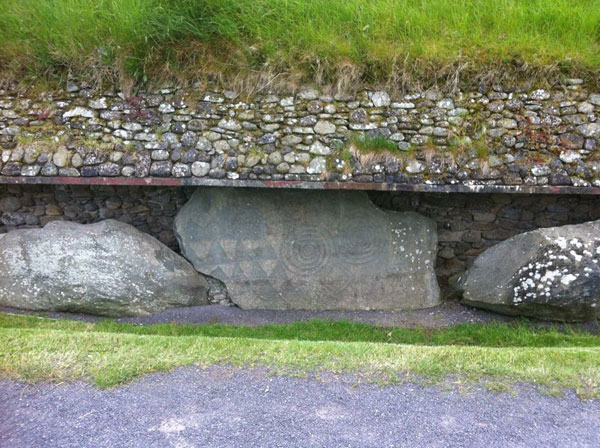
The sheer size of Newgrange would suggest that the tomb would have been used for people of High Status or Royalty within the Neolithic society.
The sheer size of the monument would have insured that it dominated the landscape of the region. Newgrange was built using a construction method known as corbeling that is visible within the burial chamber.
Newgrange is situated within a ritual landscape Bru Na Boinne that is dotted with approximately 35 smaller mounds and 2 major satellite tombs called Knowth and Dowth, the 3 tombs are the largest and most principle of the monuments.
Dowth is not on the official tour of Bru Na Boinne. Knowth is a passage tomb like Newgrange constructed in the same era of the Neolithic. It is a large mound with 18 satellite mounds surrounding the main monument. like Newgrange,
Knowth is a passage tomb but contains 2 independent passages east and west. The eastern passage like Newgrange is a passage leading to cruciform chamber that contained basin stones where cremated remains were placed.
The west passage leads to one rectangular chamber. Archaeologist uncovered over 200 decorated stones at Knowth, with carvings like those found at Newgrange but unusually some of the carvings were on the backs of the stones, making archaeologist think that the builders never meant those carvings to be seen.
Newgrange is famous for it’s Stone Age Passage Tomb. The tomb was built to mark the beginning of a new year and the winter solstice that lights up the tomb when the sun is at a certain point in the day.
It’s supposed to illuminate the entire tomb and is a spectacular site to behold.
According to ancient mythology it was created by the Tuatha Dé Danann who ruled Ireland. It were said to have built Newgrange as a burial place for their chief, Dagda Mór, and his three sons.
It was built around 3,200 BC. That’s older than Stonehendge and the Pyramids.

